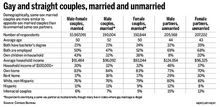Gay and straight married couples are demographically very similar in terms of likelihood to be raising children, age, income, race, whether they own or rent a home together, education levels, and employment. And both are unlike unmarried same-sex partners (and, I suspect, unmarried straight couples), who skew younger, more educated, more wealthy, are much less likely to be raising children, and are much less likely to have invested in a home together.
That's what the Census Bureau has concluded based on a sample of same-sex couples who live together and self-report as married, although the Census Bureau does not verify whether couples (gay or straight) are legally married.
Here's the Census Bureau chart, which you can enlarge by clicking on it:
If you can't see it well above, you can find it here.
There are many fascinating results here, only a couple of which I want to highlight now.
The data about child-raising is especially significant since one common argument in the SSM debate is that marriage is centrally about providing a stable environment for children. Straight married couples are somewhat more likely to be raising children (43%) than are lesbian married couples (38%) or gay-male married couples (32%). But the difference is not huge, and separates all three categories from unmarried couples, gay and straight, who are far more likely to be childless. And while lesbian married couples are more likely to be raising children, the difference between them and gay-male couples is not nearly as large as commonly thought.
Also, a higher proportion of gay male couples are married (or consider themselves married) than are lesbian couples (52% of gay male couples v. 42% of lesbian couples). Among other things, this means proportionately more lesbian than gay male couples are raising children outside of marriage (20% v. 8%).
The debate over gay marriage is moving from the abstract to the empirical. That's especially true as more states gain more experience with actual gay marriages. Unfortunately, the Census Bureau has resisted including gay married couples in the decennial census, arguing that DOMA forbids it. I'm not sure that's right, though of course the existence of DOMA didn't stop the Census Bureau from collecting this data. (UPDATE: The Wall Street Journal says the White House has now abandoned that interpretation of DOMA and is directing the Census Bureau to find ways to include same-sex married couples in the 2010 census.)
None of this demographic information proves that gay marriage "caused" anything in particular. Among other things, it seems likely that gay couples who fit a traditional profile (have children, own a home) are more likely to get married than those who don't. And of course it doesn't resolve the debate over whether states should permit gay couples to marry.
But it does fill in some important missing information about what gay families and gay marriages look like. And it turns out that, in some significant respects at least, they look a lot like traditional ones.
(HT: iMAPP)
UPDATE: Some caution about this Census data, here.
Related Posts (on one page):
- Some caution about Census data on same-sex couples:
- New Census study comparing gay and straight married couples:
